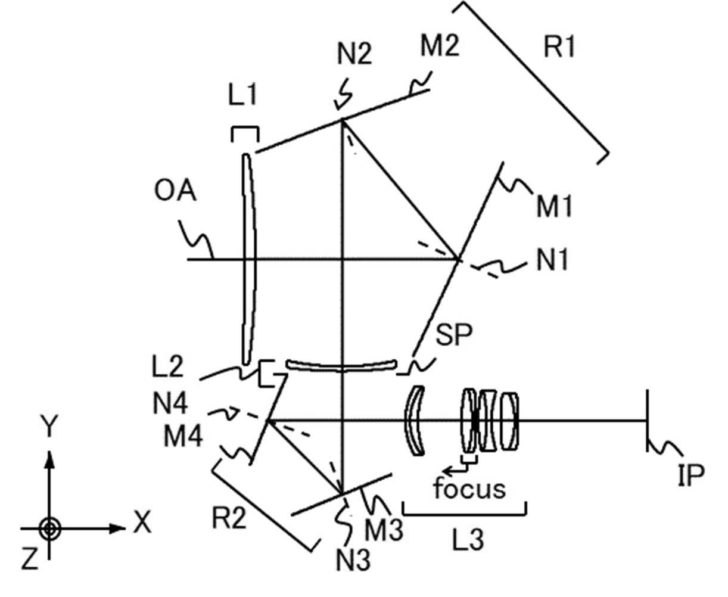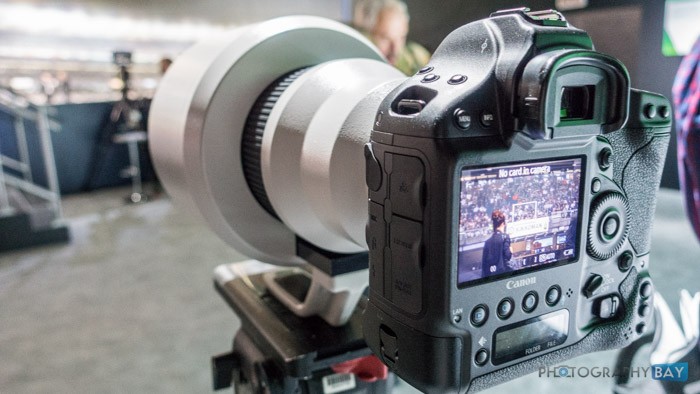Just a month after the Canon R5 came out in 2020, Canon filed a patent application – published only this morning – That attempts to make a smaller 600mm f/4, without resorting to fresnel DO optics and avoiding catadioptric designs that use a central mirror that blocks some light and causes doughnut bokeh.

This results in a two-tubes-squished-together look seen commonly among spotting scopes.
Based on the back-focus being listed as 80mm, the length of this lens appears to be about 24 (~9.5 inches) centimeters long, only about an inch and a half longer than the RF 70-200 f/2.8 L lens when shot at 200mm. The objective lens element at the end, though, would have to be the same diameter as current 600mm f/4 lenses, making it quite a stubby design.
The center of gravity would be about the same distance from the camera as where one puts a hand under a 70-200 f/2.8 lens, giving the lens quite a lot more maneuverability.
Canon plainly decided to explore all strategies when looking to improve on its supertelephoto line-up when moving to the R mount. In the meantime, it repurposed its recent EF 600mm f/4 and 400mm f/2.8 Mark III designs by slapping a permanent R mount adapter on them.
It simultaneously designed and launched a brace of small-aperture 600mm and 800mm f/11 fresnel DO lens to many positive reviews. The length of those lenses was abbreviated both by the fresnel element, and also with a collapsing optical tube that needs to be extended prior to use.
Very recently, other patents using the more traditional catadioptric “mirror lens” designs appeared from roughly the same time period.
The fact that the DO design effort required the addition of a telescoping tube to save length may indicate that Canon may have given up on the much-hoped-for 600mm f/4 DO lens that appeared briefly at a trade show as a prototype model seven years ago (pictured at top). Since that time, Canon embarked on a notably diverse research effort primarily to reduce size and weight of supertelephoto lenses, with the image quality remaining about equal to the excellent results first achieved with its EF Mark II supertelephoto lenses.
Canon's recent announcement of variations on the RF 400mm f/2.8 and RF 600mm f/4 designs – adapting them into an 800mm and 1200mm offering through the uses of teleconverting lens groups – disappointed some, as many RF supertelephoto shooters were hoping for more design innovation than adapters and teleconverters on the older EF lense designs. The lenses' reception didn't get a boost from the announced pricing, with a roughly 30 percent boost in versus with the corresponding base lense.
The strategy of re-using older designs – especially ones considered close to optical optimums – could have proved popular if the efficiencies created resulted in more people being able to purchase them.
In the meantime, Nikon's Z mount – long criticized for sporting a mostly amateur lens lineup – two days ago started delivering its 400mm f/2.8 lens that comes with an internal, switchable teleconverter, rendering the lens also a 560mm f/5.6. To top it off, it started seeding some pre-production models of its svelte 800mm f/6.3 fresnel-based design lens last week. That lens is rumored to cost about a third the price of the announced upcoming 800mm RF lens. That difference in price between Canon's new 800mm lens and Nikon's is about the price of a copy of Nikon's new flagship Z9 camera.


But F5.6 or F6.7 lenses would be a step in the right direction, forming a sensible and relatively affordable compromise between the 600mm F4 and the 600mm F11. The gap between these lenses is huge, and needs very much to be bridged.
To me, the RF 400/600/800/1200 supertele lenses seem like Canon going after the low-hanging fruit from a design standpoint. The EF 400 and 600 were recently redesigned with many changes from the MkII. The 300 and 500 didn’t get that overhaul, so perhaps Canon will design them from the ground up, maybe with a built-in 1.4x or something else novel. But that’s more work, meaning more time, and Canon would rather develop products with a wider market first.
Moving on....